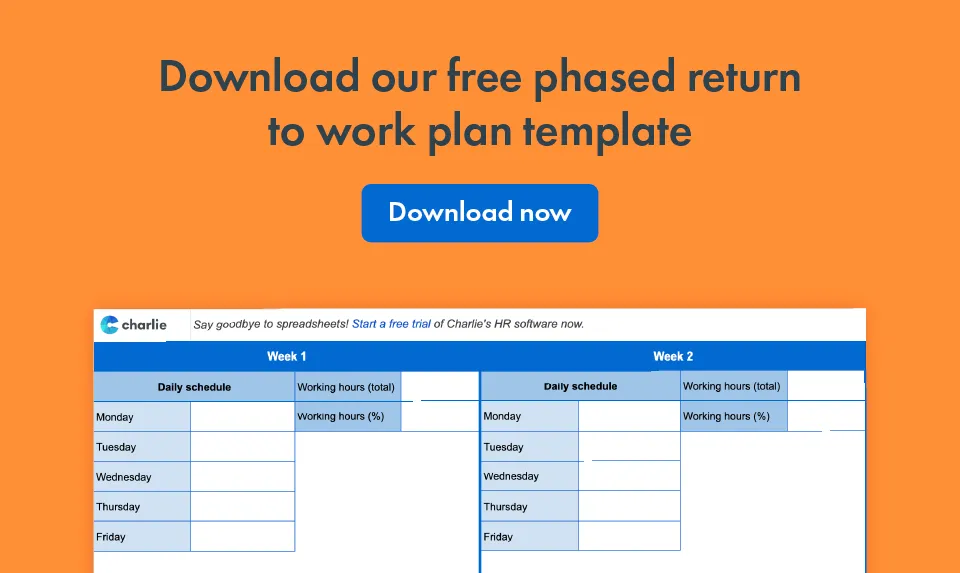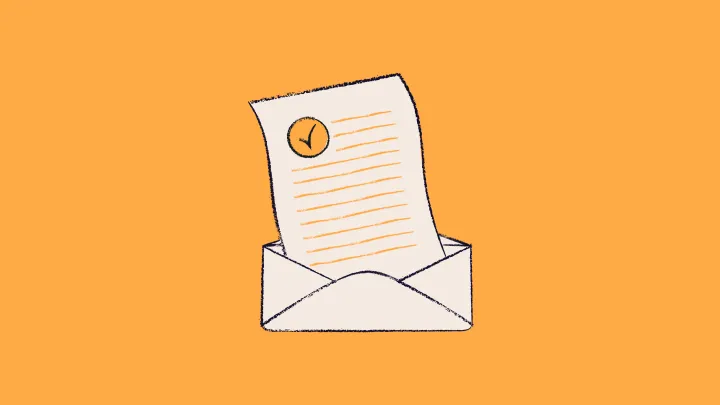What is a phased return to work plan? (With free template)

From time to time, members of your team may have to be off work for extended periods of time – this could be because of illness, injury, bereavement, parental leave, or something else entirely.
When they’re ready to come back, a phased return to work plan will make the transition easier for them, as it will allow them to gradually build back up to their usual role and working pattern in a clear and structured way.
As an employer, managing absence and returns to work can be a fine balance. Obviously, you want to be supportive of your employees, but you also need to protect the business.
As one of Charlie’s qualified HR advisors, I specialise in helping small businesses stay compliant while simultaneously creating a company culture where their employees feel supported and engaged.
In this blog, I’ll explain what a phased return to work plan is, when to use one, and how to apply it to various different scenarios.
Phased return-to-work plans takes your employees’ health, wellbeing, and ability to readjust into consideration to support them to return to the workplace. Done right, they can be positive for your business as well. Download our phased return to work plan template now or keep reading to find out more.
What is a phased return to work?
A phased return to work is when an employee is supported to gradually return to their role, or normal working hours after being absent for an extended period of time.
This staggered return to work phase typically takes place over 4-6 weeks, with the aim of easing the transition so it’s less intimidating and more manageable for the employee.
What is an example of a phased return to work?
No phased return to work will be exactly the same, as it will depend on the reason for an employee’s absence and the role they are returning to. However, there are commonalities:
- Gradually increasing working hours over several weeks is likely to be a part of most phased returns. Coming back full-time is likely to feel too much for anyone who’s been away for a while — regardless of the reason.
- Only working mornings for a week or two may be part of a phased return to work plan for someone who has been absent because of stress or is still suffering from fatigue
- Starting later and finishing earlier could assist someone who is recovering from an injury. So although the reason for the phased return is different, the planned approach to managing it may be the same or similar.
When should an employee have a phased return to work?
An employee can request a phased return if they feel that coming back to work full-time and resuming all of their duties is too complicated or intimidating. Phasing them back in after a prolonged absence will hopefully alleviate feelings of unease, and transition them back into their role within a set time frame.
Please note that phased returns are at the discretion of the employer.
Types of a phased return to work and examples of what each can be
There are various reasons why members of your team may have to have extended absences from work, and these could all result in them requiring a phased return when they’re ready to come back – let’s see what they can be and some examples of what they are.
Returning to work after an illness or surgery
When illness or surgery has prevented someone from working and has required treatment and/or recovery time.
The returning employee might:
- Only work mornings for a week or two
- Work shorter days, starting later and finishing earlier.
Phased returns can also relate to tasks that normally form a part of a role. So if someone has had major surgery then their plan could include the need for lighter physical duties.
Equally, employers must make reasonable adjustments for any team member with a disability, so their phased return to work plan would need to have these included. This might be anything from providing specialist equipment to staggering the working hours or reviewing and amending certain tasks.
See our workplace accident report for more information.
Returning to work after long-term sickness
When an employee has been signed off by their GP on long-term sick leave, either for mental or physical health reasons.
As well as reducing their working hours for the first few weeks, a plan for someone coming back after being on long-term sick might include a change to their normal duties.
Returning to work after parental (maternity and paternity) leave
When a member of the team becomes a parent. In the UK, new mums take 39 weeks of maternity leave on average. They will inform you of how much leave they're taking through a maternity leave letter. Statutory paternity leave is two weeks, but some employers choose to offer more than this. Employees can also take up to 52 weeks of statutory adoption leave.
Working shorter days or weeks could be especially helpful to new parents, as it gives them space to establish a new routine.
Working two days per week, or only mornings, and building the hours up gradually might also be the main focus of their phased return plan.
Returning to work after stress leave
When someone has been signed off by their GP for work-related stress.
If someone’s been absent due to stress then taking steps to reduce anything that increases the pressure on them makes sense for a phased return. This might include elements of their normal job, like removing direct communication with customers or the need to attend meetings with senior members of the team.
Only working half days for a few weeks is also likely to help to phase them back in.
Returning to work after a bereavement
When an employee has suffered the loss of a family member or loved one.
Listening to and accommodating the needs of your employee is essential for any successful phased return, but perhaps no more so than here.
Any of the approaches above may be applicable, but you probably need to talk through all of the possible options so your team member can choose what feels right for them.
For example, one person might want to return to normal as quickly as possible, so working every day, but for fewer hours, might help with that. But someone who is struggling might need more time to rest. So they might prefer to work 2-3 full days, with a longer weekend on either side.
By their very nature, phased returns are entirely individual. How you plan for any employee to come back to the workplace will depend on what they normally do for a job, and why they've been absent.
What is a phased return to work plan?
A phased return to work plan is a structured approach that allows employees to gradually transition back to their regular job and schedule after a period of absence.
The plan works as a step-by-step process, where a team member’s workload or working hours are gradually increased over a set period — typically, 4-6 weeks. The specifics of each plan will vary, depending on individual circumstances and company policy.
Download our free phased return to work plan template.

How to use the phased return to work plan template
Our HR template includes a section for ‘working hours’ per week, which can be adapted for full or part-time employees.
For a phased return to work plan to be effective it should be:
- Completed over a set period of time, but be flexible enough to take into account the needs of the business and the employee
- ‘Owned’ by both the line manager and the returning team member — the plan should be agreed between both parties before the return date
- Reviewed regularly throughout the phased return period of time, especially at the ‘progress meetings’, which should ideally be held every week.
As you can see from the plan example on the template, everything is set out week by week, including the percentage of normal working hours worked per week, the week’s objective, and the date and time of that week’s progress meeting.
This clarity helps to provide your employee with further reassurance during their phased return. A phased return to work plan is a structured approach that’s good for the employee, and good for you as the employer, as everyone can see the goals you’re collectively working towards.
For example, the plan will likely show the returning employee working mornings only in their first week back; the hours will increase incrementally week by week, until they’re 100% of normal working hours by week 6.

How does a phased return affect pay?
The rate of pay during a phased return to work depends on sick pay entitlement.
If an employee has been paid statutory sick pay while they’ve been off, they should earn (a percentage of) their normal wage when they begin their phased return.
If they’ve been paid in full under occupational sick pay, their wage will stay the same as they’ll get full pay for the time they’re at work and sick pay for the rest.
If you’re unsure of what you should pay your team while they’re absent from work or going through a phased return, you may want to consider opting in for Charlie’s HR Advice service. This is a bespoke support service that helps small companies and startups by providing expert and on-demand HR advice.
Can Charlie help you run and organise phased return-to-work plans?
Yes, it can! A modern HR system like Charlie will keep all of your records, including any phased return-to-work plans, in order at all times. It helps you to stay compliant and saves you time and a whole lot of faff.
- Charlie is designed to collect all the data required by the law, so there’s no chance you’ll ever forget anything.
And with our HR Advice service, you’ll have the peace of mind of always being on the right side of the law.
- Your dedicated advisor will be by your side, recommending the best way to approach difficult employee situations, in a way that’s both human and compliant.
Charlie makes HR effortless.

Want to get access to more HR templates? Have a look below:


